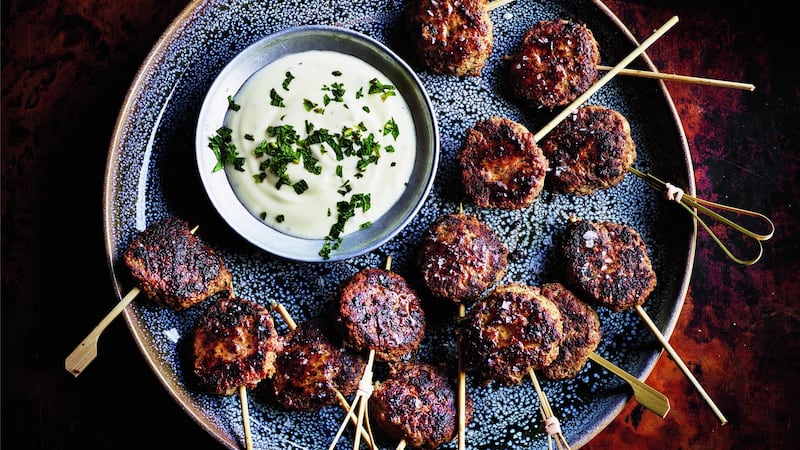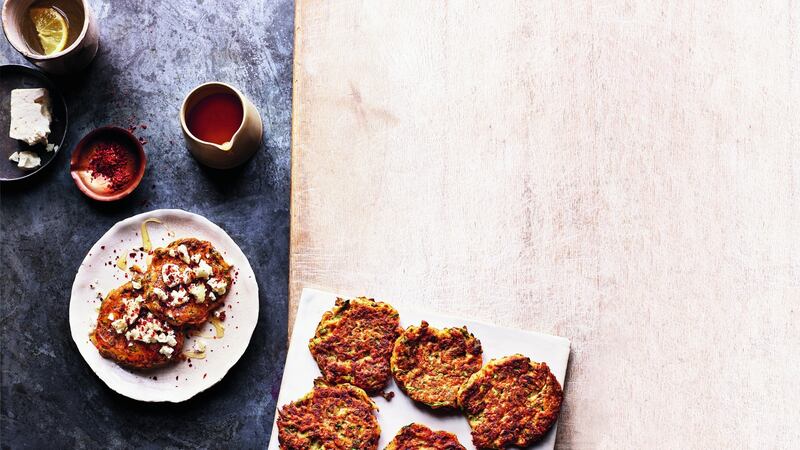“In my pitch to my publishers, I couldn’t really describe the recipes, so I just said, ‘Listen I’ve got soya sauce and fish sauce and harissa and all kinds of mishmash of ingredients and I don’t know if it’s Eastern or if it’s Western, it’s just simply Sabrina food’.”
The Sabrina doing the talking is UK-based, Persian-born food writer Sabrina Ghayour, and the product of that pitch is her fifth cookery book, Simply: Easy Everyday Dishes, which has just been published.
Ghayour is no stranger to blending influences from the food of her ancestry with that of South East Asia, where she is a frequent visitor, and the UK, which has been her home since she arrived with her mother at the age of two. It has been a recurring theme in her writing, and in Simply, for example, you’ll find a recipe for chicken wings flavoured with fish sauce and rose harissa, the Asian and Middle Eastern ingredients brought together in a cross-cultural fusion along with lime juice and honey. “I’m opening up the pantry. It’s a little bit East, a little bit West ... It’s what I’m known for now,” she says.
But with cultural appropriation in food and recipe writing such a sensitive topic, could Ghayour’s approach leave her open to criticism? “I understand people wanting to preserve tradition, history and culture and I think that’s beautiful. However, we need to be realistic about this, and if I perhaps take the liberty of speaking about my own culture’s food, the reality is a lot of those recipes are quite long winded and process-laden.
“If small modifications and simplifications with the aim of merely opening up the cuisine to other people is what you have to do to further that culture, then I’m wholly behind it. But messing around with things for the sake of it and then calling them the same thing? No, I won’t back that.”
And what about combining ingredients from several cuisines in one recipe? “I’m not calling it something it’s not. I am fully admitting it’s a fusion of ingredients,” she says. “I don’t have a bee in my bonnet about authenticity quite the same way that some people do.”
There is a right and a wrong way to go about changing or adapting recipes that have cultural significance, she believes. “Let’s say we’re talking about Irish stew, and I say, ‘now I’m pouring some nice French red wine into it’, can you imagine the kick-off? Then that becomes disrespectful, but if I say I am inspired by Irish stew and I am using all the same ingredients, but actually I like this version with red wine, and it’s not Irish stew, but it’s inspired by my love of it, then it’s a whole different ball game. There is a way to pay respect to recipes, I feel.”
Since the start of the Covid-19 crisis, Ghayour has been living with her mother at the house she bought in a quiet Yorkshire village and moved into in January of last year. Previously, she was London-based, and until the start of the pandemic only spent a few days a month in Yorkshire, with consultancy projects, teaching and supper club commitments keeping her in the UK capital.
But Covid-19 has changed her focus. “I’m in Yorkshire full time because social distancing means I can’t resume normal business and I don’t want to, even though I’m getting so many requests asking if I’ve got a supper club or a cookery class sometime soon. I just don’t see it as essential, and I don’t want to take risks. I’ve written it all off until next year.”
Her frequent long-haul trips, for work and research, as well as pleasure, have also been knocked on the head for now. She was in Thailand and Myanmar in January, and was to go to Tanzania in March, with her mother, but world events took over. “So we cancelled it and came up here with the intention of staying here for a couple of weeks instead - and didn’t leave. It’s the smartest thing we did.”

LAMB AND MINT KOFTE
These simple yet delicious little kofte are based on something I tasted in a restaurant in Antakya (the Ancient Roman city of Antioch in southern Turkey), and use dried mint – a wonderfully versatile ingredient. These kofte really are pleasingly straightforward and a recipe that I’ve made many times since coming back from that trip.
Makes about 20
Ingredients
500g minced lamb
1 onion, minced in a food processor and drained of any liquid, or very finely chopped
2 tbsp dried mint
2 eggs
Vegetable oil, for frying
Generous amount of Maldon sea salt flakes and freshly ground black pepper
To serve: Greek or natural yogurt, chopped fresh mint leaves
Method
1 Put all the main ingredients, except the vegetable oil, into a large mixing bowl and, using your hands, work them together really well, pummelling the meat mixture for several minutes into a smooth, even paste.
2 Take golf-ball-sized amounts of the mixture and shape into round patties, about 20 in total.
3 Heat a large frying pan over a medium-high heat. Once hot, drizzle in a little vegetable oil and cook the patties in batches for 3-4 minutes on each side until browned on both sides and cooked through.
4 Thread each patty on to a little wooden skewer and serve with a bowl of Greek or natural yogurt scattered with some chopped fresh mint for dipping.

COURGETTE AND OREGANO PANCAKES WITH FETA AND HONEY
Courgettes are so versatile, and I absolutely love the Turkish take on them in the form of courgette and feta fritters called mücver. Taking inspiration from them, these pancakes make for a wonderful breakfast or brunch dish, topped with creamy, salty feta and a good drizzle of sweet honey – my idea of perfection.
Makes about 16
Ingredients
2 large courgettes
2 eggs
4 tbsp plain flour
1 teaspoon baking powder
½ small packet (about 15g) of fresh oregano, leaves finely chopped
1 tsp cumin seeds
1 heaped tsp pul biber (Aleppo) chilli flakes, plus extra to serve
Vegetable oil, for frying
Maldon sea salt flakes and freshly ground black pepper
To serve: 100g vegetarian feta cheese, crumbled, clear honey
Method
1 Coarsely grate the courgettes into a bowl. Tip them into a clean tea towel, gather up the sides and squeeze out the liquid from the courgettes. Place in a mixing bowl, add the eggs, flour, baking powder, oregano, cumin and pul biber, season generously with salt and pepper and beat together.
2 Place a large frying pan over a medium-high heat and drizzle in some vegetable oil. Using a tablespoon measure, roughly fill the scoop with the courgette mixture and without overcrowding add dollops to the pan, then gently flatten. Fry for about 1 minute until the undersides are nicely browned, then flip over and cook until the other sides have browned. Remove from the pan and repeat with the remaining mixture.
3 Serve the pancakes immediately topped with the crumbled feta, a little drizzle of honey and a sprinkling of pul biber.

CHORIZO, GOATS’ CHEESE AND CUMIN BOREK
Although not a traditional borek filling, this wonderful combination of smoky, spiced chorizo and cumin-spiked, creamy goats’ cheese is a winner. Chorizo really is such a fantastic ingredient and its capability to deliver bags of flavour to anything it comes into contact with always makes it a crowd-pleaser and a refrigerator staple in my household.
Serves 4-6
Ingredients
2 x 200g cured (not cooking) chorizo sausages, skinned and cut into chunks
2 tsp cumin seeds, toasted
350g rindless soft goats' cheese
Vegetable oil, for oiling
6 sheets of filo pastry (each about 48 x 25cm)
1 tbsp milk or water
Beaten egg, to glaze
1 tsp nigella seeds
Method
1 Preheat the oven to 200 degrees celsius (180 fan), or gas mark 6.
2 Put the chunks of chorizo into a food processor and process until they are minced as finely as possible. Transfer to a mixing bowl, add the cumin seeds and goats' cheese and mix together until evenly combined.
3 Brush the base of a 24cm round ovenproof dish or cake tin with a little vegetable oil. Lay a pastry sheet lengthways in the dish or tin with the ends overhanging the sides, then lay another pastry sheet widthways in the same way.
4 Divide the chorizo filling in half. Add one half to the filo base and smooth it right to the edges to cover the base evenly. Fold another pastry sheet in half to create a double thickness and lay it over the filling, then repeat with a second pastry sheet to form a thick pastry layer.
5 Brush the pastry with the milk or water, then top with the remaining filling, pushing and patting it into place to evenly coat the pastry layer. Fold the overhanging pastry into the centre, then gently crumple up the remaining 2 pastry sheets and arrange them on top.
6 Brush all the exposed pastry and edges with beaten egg, and sprinkle over the nigella seeds. Bake for 25-24 minutes until deep golden brown. Serve immediately.
Simply: Easy Everyday Dishes by Sabrina Ghayour is published by Mitchell Beazley, £26. Photography: Kris Kirkham.











